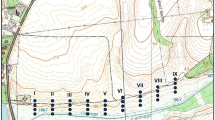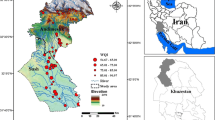Abstract
In this technical note, we investigate the hypothesis that ‘non-linearity matters in the spatial mapping of complex patterns of groundwater arsenic contamination’. The spatial mapping pertained to data-driven techniques of spatial interpolation based on sampling data at finite locations. Using the well known example of extensive groundwater contamination by arsenic in Bangladesh, we find that the use of a highly non-linear pattern learning technique in the form of an artificial neural network (ANN) can yield more accurate results under the same set of constraints when compared to the ordinary kriging method. One ANN and a variogram model were used to represent the spatial structure of arsenic contamination for the whole country. The probability for successful detection of a well as safe or unsafe was found to be atleast 15% larger than that by kriging under the country-wide scenario. The probability of false hopes, which is a serious issue in public health monitoring was found to be significantly lower (by more than 10%) than that by kriging.




Similar content being viewed by others
Notes
This algorithm is not very sensitive to the choice of τ, but a rule of thumb, a small value is used, e.g. τ = 10−6 if x 0 is believed to be a good approximation of x *.
References
Ahmed MF (2003) Arsenic contamination: Bangladesh perspective. ITN, BUET, Dhaka, Bangladesh
ASCE Task Committee (2000) Artificial neural networks in hydrology. II: hydrologic applications. ASCE J Hydrol Eng 5(2):124–136
Berg M, Tran HC, Nguyen TC, Pham TV, Schertenleib R, Giger W (2001) Arsenic contamination of ground water and drinking water in Vietnam: a human health threat. Environ Sci Technol 35(13):2621–2626
Besaw LE, Rizzo DM (2007) Stochastic simulation and spatial estimation with multiple data types using artificial neural networks. Water Resour Res 43:W11409. doi:10.1029/2006WR005509
BGS-DPHE (2001). Arsenic contamination of groundwater in Bangladesh. Kinnburgh DG, Smedley PL British geological survey report WC/00/19, vol 1–4, British Geological Survey, Keyworth, UK. Available at: http://www.bgs.ac.uk/arsenic/. Accessed 1 November 2008
Del Razo LM, Rellano MA, Cebrian ME (1990) The oxidation states arsenic in well-water from a chronic arsenicism area of Mexico. Environ Pollut 64:143–153
Deutsch C, Journel A (1998) GSLIB: geostatistical software library and user’s guide. Oxford University Press, UK, p 340
Faybishenko B (2002) Chaotic dynamics in flow through unsaturated fractured media. Adv Wat Resour 25(7):793–816
Goovaerts P, AvRuskin G, Meliker J, Slotnick M, Jacquez G, Nriagu J (2005) Geostatistical modeling of the spatial variability of arsenic in groundwater of southeast Michigan. Wat Resour Res 41(W07013). doi:10.1029/2004WR003705
Govindaraju RS, Rao AR (2000) Artificial neural networks in hydrology. Kluwer Academic Publishers, Amsterdam
Hill AJ, Hossain F, Sivakumar B (2008) Is correlation dimension a reliable proxy for the number of influencing variables required to model risk of arsenic contamination in groundwater? Stoch Env Res Risk A 22(1):47–55. doi:10.1007/s00477-006-0098-6
Hindmarsh JT, McCurdy RF (1986) Clinical and environmental aspects of arsenic toxicity. Crit Rev Clin Lab Sci 23:315–347
Hossain F, Sivakumar B (2006) Spatial pattern of arsenic contamination in shallow tubewells of bangladesh: regional geology and non-linear dynamics. Stoch Env Res Risk A 20(1–2):66–76. doi:10.1007/s00477-005-0012-7
Hossain F, Hill AJ, Bagtzoglou AC (2007) Geostatistically-based management of arsenic contaminated ground water in shallow wells of Bangladesh. Wat Resour Manage 21:1245–1261. doi:10.1007/s11269-006-9079-2
Kinniburg DG, Smedley PL (2001) Editors. Arsenic contamination of groundwater in Bangladesh, Ministry of Local Government, Rural Government and Cooperatives, Government of Bangladesh; BGS Technical Report WC/00/19, vol 1
Mazumder GDN, Haque R, Ghosh N, De BK, Santra A, Chakraborti D, Smith AH (1998) Arsenic levels in drinking water and the prevalence if skin lesions in West Bengal, India. Int J Epidemiol 27(5):871–877
Nahar N, Hossain F, Hossain MD (2008) Health and socio-economic effects of groundwater arsenic contamination in rural Bangladesh: evidence from field surveys, international perspectives. J Environ Health 70(9):42–47
Nocedal J, Wright SJ (1999) Numerical optimization. Springer, New York, p 636
Rahman MM, Mukherjee D, Sengupta MN, Chowdury UK, Lodh D, Chanda CN, Roy S, Selim M, Quamruzzaman Q, Milton AH, Shadullah SM, Rahman MT, Chakraborti D (2002) Effectiveness and reliability of arsenic field testing kits: are the million dollar screening projects effective or not? Environ Sci Technol 36:5385–5394
Rahman S, Hossain F (2008) A forensic look at groundwater arsenic contamination in Bangladesh. Environ Forensics 9(4). doi:10.1080/15275920801888400
Schwartz RA (1997) Arsenic and the skin. Int J Dermatol 36:241–250
Tseng T, Babazono A, Yamamoto E, Kurumatani N, Mino Y, Ogawa T, Kishi Y, Aoyama H (1968) Ingested arsenic and internal cancer in an endemic area of chronic arsenicism in Taiwan. J Natl Cancer Inst 40:453–463
Twarakavi NKC, Kaluarachchi J (2006) Arsenic in the shallow ground waters of conterminous United States: assessment, health risks, and costs for MCL compliance. J Am Wat Resour Assoc 42(2):275–294. doi:10.1111/j.1752-1688.2006.tb03838.x
Yu WH, Harvey CM, Harvey CF (2003) Arsenic groundwater in Bangladesh: a geostatistical and epidemiological framework for evaluating health effects and potential remedies. Water Resour Res 39(6):1146. doi:10.1029/2002WR001327
Acknowledgments
The authors wish to acknowledge the constructive reviews received from two anonymous reviewers. The first author was supported by the Center of Management, Protection and Utilization of Water Resources at Tennessee Technological University and the Ivanhoe Foundation.
Author information
Authors and Affiliations
Corresponding author
Appendix
Appendix
1.1 Training of artifical neural network
The algorithm for training of ANN employs damped Gauss–Newton method utilizing a damping parameter μ as follows,
where, J ∈ R is a Jacobian Matrix, which contains the first partial derivatives of the function component \( \left\| {f(x)} \right\|, \) that need to be minimized,
f has continuous second partial derivatives, that can be written from Taylor expression as follows,
Here, h lm is the step used in this LM method and g is a variable which depends on step size (h lm) and damping parameter (μ).
Also, J = J(x) and f = f(x). The damping parameter μ has several effects as follows:
For all μ > 0 the coefficient matrix is positive definite. This ensures that h lm is a direction downhill. For large values of μ we get, \( h_{\text{lm}} \approx - \frac{1}{\mu }g = - \frac{1}{\mu }F^{\prime}(x) \) i.e. a short step in the steepest descent direction. This is good if the current iteration is far from the solution. If μ is very small, then h lm ≈ h gn; h gn = Gauss–Newton step. This is beneficial in the final stages of the iteration, when x is close to x *. If F(x *) = 0 (or very small), then we can get (almost) quadratic final convergence.
The damping parameter μ influences both the direction and the size of the step. The choice of initial μ value should be related to the size of the elements in A 0 = J(x 0)T J(x 0), e.g. by letting μ 0 = τ.max i {a (0) ii }, where τ is chosen by user.Footnote 1
Updating of the damping parameter μ is controlled by the gain ratio,
Here,
Inserting Eq. 9 in Eq. 7 we find that
The denominator of Eq. 8 is the gain predicted by the linear model of Eq. 10 as follows,
Both h Tlm h lm and −h Tlm g are positive definite, so L(0) − L(h lm) is guaranteed to be positive.
A large value of gain ratio, ξ indicates that L(h lm) is a good approximation to F(x + h lm), and we can decrease μ so that the next Levenberg–Marquardt step is closer to the Gauss–Newton step. If ξ is small (may be even negative), then L(h lm) is a poor approximation, and we should increase μ with the twofold aim of getting closer to the steepest descent direction and reducing the step length.
The stopping criteria for the algorithm should reflect that at a global minimizer we have F′(x *) = g(x *) = 0 so we can use,
Another relevant criterion is to stop if the change in x is small,
This expression gives a gradual change from relative step size ε 2 when \( \left\| x \right\| \) is large to absolute step size ε 22 if x is close to 0. Finally, as in all iterative processes we need a safeguard against an infinite loop,
Also ε 2 and k max are chosen by the user.
The last two criteria come into effect e.g. if ε 1 is chosen so small that effects of rounding errors have large influence. This will typically reveal itself in a poor accordance between the actual gain in F and the gain predicted by the linear model and will result in μ grows fast, resulting in small \( \left\| {h_{\text{lm}} } \right\| \) and the process will be stopped by following the stopping criterion.
Rights and permissions
About this article
Cite this article
Chowdhury, M., Alouani, A. & Hossain, F. Comparison of ordinary kriging and artificial neural network for spatial mapping of arsenic contamination of groundwater. Stoch Environ Res Risk Assess 24, 1–7 (2010). https://doi.org/10.1007/s00477-008-0296-5
Published:
Issue Date:
DOI: https://doi.org/10.1007/s00477-008-0296-5




